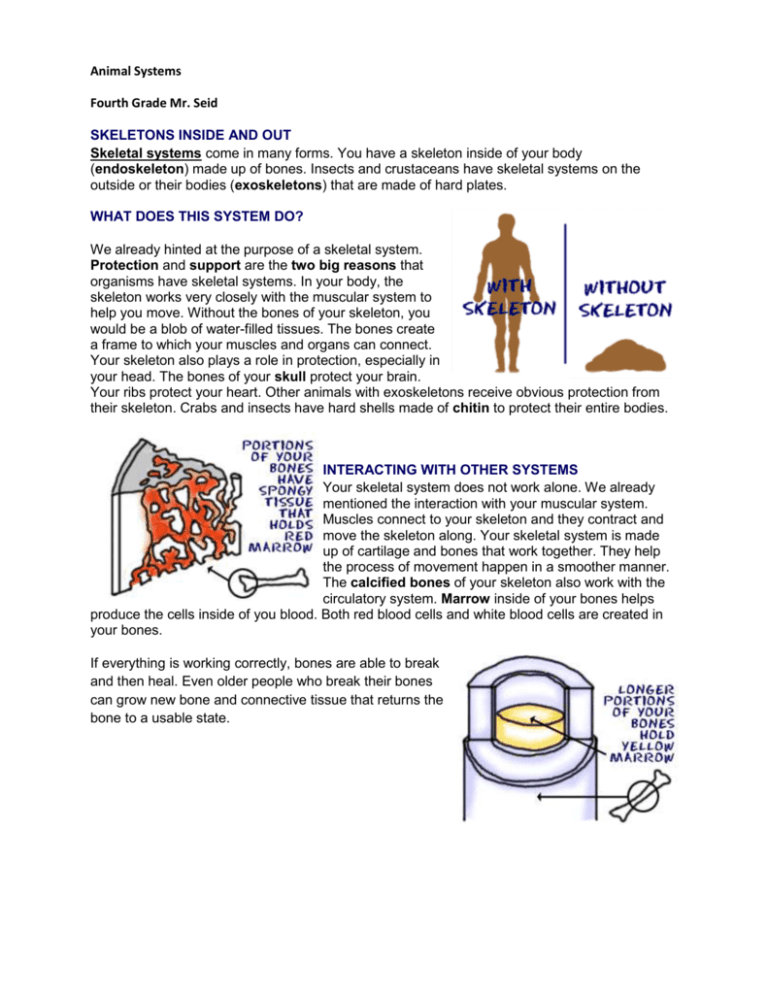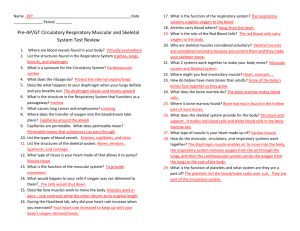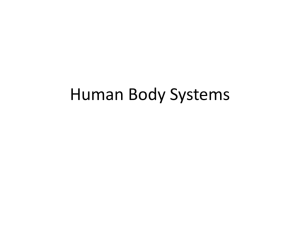What does the system do? - Mr. Seid`s 4TH Grade Website
advertisement

Animal Systems Fourth Grade Mr. Seid SKELETONS INSIDE AND OUT Skeletal systems come in many forms. You have a skeleton inside of your body (endoskeleton) made up of bones. Insects and crustaceans have skeletal systems on the outside or their bodies (exoskeletons) that are made of hard plates. WHAT DOES THIS SYSTEM DO? We already hinted at the purpose of a skeletal system. Protection and support are the two big reasons that organisms have skeletal systems. In your body, the skeleton works very closely with the muscular system to help you move. Without the bones of your skeleton, you would be a blob of water-filled tissues. The bones create a frame to which your muscles and organs can connect. Your skeleton also plays a role in protection, especially in your head. The bones of your skull protect your brain. Your ribs protect your heart. Other animals with exoskeletons receive obvious protection from their skeleton. Crabs and insects have hard shells made of chitin to protect their entire bodies. INTERACTING WITH OTHER SYSTEMS Your skeletal system does not work alone. We already mentioned the interaction with your muscular system. Muscles connect to your skeleton and they contract and move the skeleton along. Your skeletal system is made up of cartilage and bones that work together. They help the process of movement happen in a smoother manner. The calcified bones of your skeleton also work with the circulatory system. Marrow inside of your bones helps produce the cells inside of you blood. Both red blood cells and white blood cells are created in your bones. If everything is working correctly, bones are able to break and then heal. Even older people who break their bones can grow new bone and connective tissue that returns the bone to a usable state. MUSCULAR SYSTEM - MEAT ON THE BONES Many advanced animals have muscular systems. You know you do. Did you know that your muscular system is made up of three different types of muscular tissue? You have smooth, cardiac, and voluntary muscle tissue in your body. Smooth muscle is muscle you rarely control such as the muscle in your stomach. Cardiac or Heart Muscle is very specific tissue found in your heart. Voluntary muscle is the muscle that helps you move. All of those tissues add up to a muscular system that is found through your body. There is more to the muscular system than the muscles that help you move. WHAT DOES THIS SYSTEM DO? The big purpose of the muscles found in your body is movement. We could be talking about the movement of your legs while you walk. We could be talking about the beating of your heart. We could also be talking about the contraction of a very small blood vessel in your brain. MUSCLES HELP YOU MOVE The main parts of your voluntary muscular system include the muscles, and tendons. The muscle is called the meatus. It happens to be the meat you eat from cows, sheep, and includes the muscle in your biceps. So your bicep is the meat, that meat needs to connect to the bones so that you can move. CIRCULATION IS THE KEY The circulatory is a system of vessels that pass through your entire body. You may read about two types of circulatory systems in animals. There are open circulatory systems in primitive organisms where you will find a heart that pumps fluids through the creature, but no complete system of vessels. More advanced organisms, including you, have closed circulatory systems where the heart is connected to a complete system of vessels. The fluids of a closed circulatory system never leave the vessels. WHAT DOES THIS SYSTEM DO? How does a circulatory system help you? It is the transportation system for your body. The circulatory system carries chemicals to all points in your body. The fluids also carry waste products and dissolved gases for your cells. Think of the chemical compounds as cars and the circulatory system as a network of freeways, main streets, and side streets. The cars can pass from one building to another using these streets in the same way that a compound might be created in the brain and sent to the kidneys. INTERACTING WITH OTHER SYSTEMS The circulatory system touches every organ and system in your body. The system is connected to all of your body's cells so that it can transport oxygen efficiently. When you breathe, the circulatory system carries oxygen to your cells and carries dissolved carbon dioxide back to the lungs. BASIC PARTS The core components of your circulatory system are the heart and vessels. You happen to have a four-chambered heart while other organisms may have one, two, or three chambers. The heart is the pump for the system. As blood is pumped from the heart, it passes through a system of arteries, and capillaries. The capillaries are the vessels that allow for most of the transfer of compounds and dissolved gases. After the capillaries, your blood passes through veins. The veins lead the circulatory fluids back to the heart. RESPIRATORY SYSTEM - ALL ABOUT BREATHING Your respiratory system is all about exchanging gases with the environment. Some animals such as amphibians are able to exchange gases through their moist skin. Fish have gills while mammals, birds, and reptiles have lungs. Your respiratory system is made of your nose and mouth, a tube called the pharynx, another tube called the trachea, and your lungs. You have two lungs and the exchange of gases between the circulatory and respiratory systems happens in the lungs. WHAT DOES THIS SYSTEM DO? Animals need oxygen (O) to survive. In fact, all organisms need oxygen to complete the process to burning glucose for fuel. Even protists and plants need oxygen, but as you become more active, you need a lot of oxygen. That's where your respiratory system comes in. It's purpose is to bring oxygen into your body. One of the products of cellular respiration is carbon dioxide. Your respiratory system also helps your body get rid of that carbon dioxide. While you have lungs, fish have gills that serve as the location for that transfer of gases. Whatever animal you study, oxygen is taken in and carbon dioxide let out. EATING AND ELIMINATION! Digestive System This is our favorite system. We love to eat and we love to poop. For the rest of the page we will refer to pooping as elimination. It's more technical that way. Anyway, your digestive system is all about getting food into your body, digesting the food, absorbing the nutrients you need, and elimination of the materials you don't need (feces). All animals have one sort of digestive system or another. Why? Anything that eats another creature (heterotrophs) must have a way of bringing nutrients in and getting rid of what they don't need. WHAT DOES THIS SYSTEM DO? What does the system do? We're going to use you as the basis for our explanation of the digestive system. Let's start with eating. You get hungry and you eat. Once you put the food in your mouth, you start to chew and begin a process of mechanical digestion that grinds food down into a pulp. Your body also starts to release chemicals that start the process of chemical digestion and the breakdown the cells of the stuff you’re eating. Most chemical digestion happens in the stomach. The food moves through your digestive system and is eventually broken down into compounds and nutrients that your small intestine can absorb into the blood stream. The material you don't absorb continues into the large intestine where water is removed from the material and then whatever is left can be eliminated at your convenience. That's a decent overview of the process. Calcium Rich Diet You probably learn about getting enough calcium in your diet. Your bones, tissues, and nervous system all need that calcium. Did you know that some people who don't have enough calcium (Ca) in their diets replace the calcium in their bones with magnesium? It can happen because calcium and magnesium are so similar on an atomic level. NERVOUS SYSTEM - I'M SENSING SOMETHING Since you're reading this page, we figure you've got a nervous system. If you were an insect you would also have a nervous system, but it would be a lot simpler. Even animals that don't think have simple nervous systems called nerve nets that help them move. Your nervous system is divided into two parts. Your central nervous system includes your brain and your spinal cord. Your peripheral nervous system is made up of the network of neurons that spans your organs, muscles, and body. The neurons in both systems work together to help you think, survive, and change the world around you. WHAT DOES THIS SYSTEM DO? The nervous system is about letting animals feel things. All of your feelings and senses are taken in through the nervous system and this sends messages to your brain.







